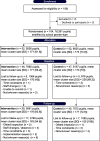The effect of a one-year vigorous physical activity intervention on fitness, cognitive performance and mental health in young adolescents: the Fit to Study cluster randomised controlled trial
- PMID: 33789683
- PMCID: PMC8011147
- DOI: 10.1186/s12966-021-01113-y
The effect of a one-year vigorous physical activity intervention on fitness, cognitive performance and mental health in young adolescents: the Fit to Study cluster randomised controlled trial
Abstract
Background: Physical activity (PA) may positively stimulate the brain, cognition and mental health during adolescence, a period of dynamic neurobiological development. High-intensity interval training (HIIT) or vigorous PA interventions are time-efficient, scalable and can be easily implemented in existing school curricula, yet their effects on cognitive, academic and mental health outcomes are unclear. The primary aim of the Fit to Study trial was to investigate whether a pragmatic and scalable HIIT-style VPA intervention delivered during school physical education (PE) could improve attainment in maths. The primary outcome has previously been reported and was null. Here, we report the effect of the intervention on prespecified secondary outcomes, including cardiorespiratory fitness, cognitive performance, and mental health in young adolescents.
Methods: The Fit to Study cluster randomised controlled trial included Year 8 pupils (n = 18,261, aged 12-13) from 104 secondary state schools in South/Mid-England. Schools were randomised into an intervention condition (n = 52), in which PE teachers delivered an additional 10 min of VPA per PE lesson for one academic year (2017-2018), or into a "PE as usual" control condition. Secondary outcomes included assessments of cardiorespiratory fitness (20-m shuttle run), cognitive performance (executive functions, relational memory and processing speed) and mental health (Strength and Difficulties Questionnaire and self-esteem measures). The primary intention-to-treat (ITT) analysis used linear models and structural equation models with cluster-robust standard errors to test for intervention effects. A complier-average causal effect (CACE) was estimated using a two-stage least squares procedure.
Results: The HIIT-style VPA intervention did not significantly improve cardiorespiratory fitness, cognitive performance (executive functions, relational memory or processed speed), or mental health (all p > 0.05). Subgroup analyses showed no significant moderation of intervention effects by sex, socioeconomic status or baseline fitness levels. Changes in cardiorespiratory fitness were not significantly related to changes in cognitive or mental health outcomes. The trial was marked by high drop-out and low intervention compliance. Findings from the CACE analysis were in line with those from the ITT analysis.
Conclusion: The one-academic year HIIT-style VPA intervention delivered during regular school PE did not significantly improve fitness, cognitive performance or mental health, but these findings should be interpreted with caution given low implementation fidelity and high drop-out. Well-controlled, large-scale, school-based trials that examine the effectiveness of HIIT-style interventions to enhance cognitive and mental health outcomes are warranted.
Trial registration: ISRCTN registry, 15,730,512 . Trial protocol and analysis plan for primary outcome prospectively registered on 30th March 2017. ClinicalTrials.gov , NCT03286725 . Secondary measures (focus of current manuscript) retrospectively registered on 18 September 2017.
Keywords: Adolescence; Cardiorespiratory fitness; Cluster randomised controlled trial; Cognition; Intervention; Mental health; Physical activity.
Conflict of interest statement
The authors declare that they have no competing interests.
Figures


References
Publication types
MeSH terms
Associated data
Grants and funding
LinkOut - more resources
Full Text Sources
Other Literature Sources
Medical

